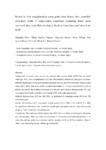Mostrar o rexistro simple do ítem
Results in liver transplantation using grafts from donors after controlled circulatory death: a single-center experience comparing donor grafts harvested after controlled circulatory death to those harvested after brain death
| dc.contributor.author | Otero, Alejandra | |
| dc.contributor.author | Vázquez, María Ángeles | |
| dc.contributor.author | Suárez, Francisco | |
| dc.contributor.author | Pértega-Díaz, Sonia | |
| dc.contributor.author | Rivas, José Ignacio | |
| dc.contributor.author | Mosteiro, Fernando | |
| dc.contributor.author | Gómez, Manuel | |
| dc.date.accessioned | 2022-06-30T11:55:43Z | |
| dc.date.available | 2022-06-30T11:55:43Z | |
| dc.date.issued | 2019-12-06 | |
| dc.identifier.citation | Otero A, Vázquez MA, Suárez F, Pértega S, Rivas JI, Mosteiro F, Gómez M. Results in liver transplantation using grafts from donors after controlled circulatory death: A single-center experience comparing donor grafts harvested after controlled circulatory death to those harvested after brain death. Clin Transplant. 2020 Jan;34(1):e13763. doi: 10.1111/ctr.13763. Epub 2019 Dec 30. PMID: 31808579. | es_ES |
| dc.identifier.issn | 0902-0063 | |
| dc.identifier.uri | http://hdl.handle.net/2183/31048 | |
| dc.description.abstract | [Abstract] Background: In recent years, interest in donation after cardiac death (DCD) has increased. Although DCD liver transplantation (LT) has demonstrated satisfactory long-term outcomes, different studies have shown poorer patient and graft survival after DCD than after donation after brain death (DBD). This study aimed to evaluate the results of LT using controlled DCD (cDCD) donors, specifically the incidence of primary non-function and ischemic cholangiopathy (IC), and to compare these results with those of LT using DBD in the same time period. Methods: Between June 2012 and July 2018, we performed 66 transplants using cDCD and 258 with DBD grafts. Results: The incidence of IC was similar in both groups (2% in DBD, 1.5% in DCD; P = .999). No significant differences were found for overall graft and patient survival rates between the groups at 1 and 2 years post-transplantation. Conclusions: This study provided evidence that cDCD donors exhibit excellent graft and patient survival outcomes. When the warm ischemia time is <30 minutes and cold ischemia time is <6 hours, the graft and patient survival rates and the incidence of IC in DCD are similar to those in DBD, even when using donors without age restrictions. | es_ES |
| dc.language.iso | eng | es_ES |
| dc.publisher | Wiley | es_ES |
| dc.relation.uri | https://doi.org/10.1111/ctr.13763 | es_ES |
| dc.rights | This is the peer reviewed version, which has been published in final form at Wiley Online Library. This article may be used for non-commercial purposes in accordance with Wiley Terms and Conditions for Use of Self-Archived Versions. This article may not be enhanced, enriched or otherwise transformed into a derivative work, without express permission from Wiley or by statutory rights under applicable legislation. Copyright notices must not be removed, obscured or modified. The article must be linked to Wiley’s version of record on Wiley Online Library and any embedding, framing or otherwise making available the article or pages thereof by third parties from platforms, services and websites other than Wiley Online Library must be prohibited. | es_ES |
| dc.subject | Donors and donation | es_ES |
| dc.subject | Donation after brain death | es_ES |
| dc.subject | Donation after circulatory death | es_ES |
| dc.subject | Immunosuppressant | es_ES |
| dc.subject | Liver disease | es_ES |
| dc.subject | Primary nonfunction | es_ES |
| dc.title | Results in liver transplantation using grafts from donors after controlled circulatory death: a single-center experience comparing donor grafts harvested after controlled circulatory death to those harvested after brain death | es_ES |
| dc.type | info:eu-repo/semantics/article | es_ES |
| dc.rights.access | info:eu-repo/semantics/openAccess | es_ES |
| UDC.journalTitle | Clinical Transplantation | es_ES |
| UDC.volume | 34 | es_ES |
| UDC.issue | 1 | es_ES |
| UDC.startPage | e13763 | es_ES |
Ficheiros no ítem
Este ítem aparece na(s) seguinte(s) colección(s)
-
INIBIC-ECB - Artigos [50]






